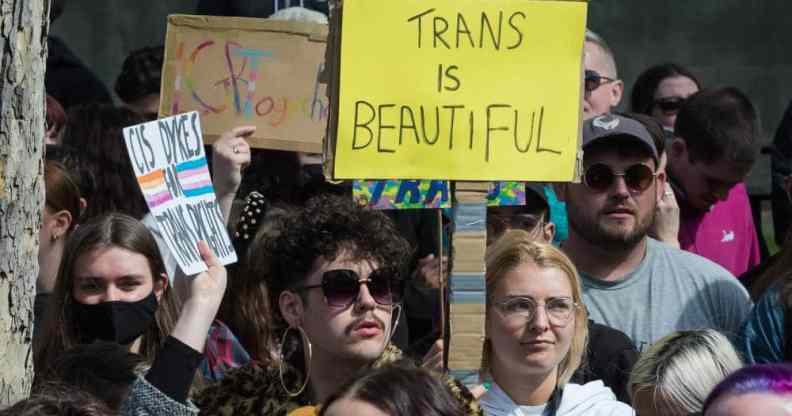Stonewall boss: ‘Census data dispels harmful myth that trans people are replacing LGB people’

Stonewall chief executive Nancy Kelley says quality population data of the trans and non-binary population could help shift the conversation in the UK. (Wiktor Szymanowicz/Future Publishing via Getty)
Stonewall boss Nancy Kelley discusses the importance of why Canada’s historic census data – which gave the first comprehensive tally of how many trans and non-binary people live in Canada – is crucial to understanding the breadth of the UK’s trans community.
A few weeks ago, Canada became the first country in the world to release census data on the trans and non-binary population.
What does it say, why does it matter?
The 2021 Canadian Census data show that trans and non-binary people make up 0.33 per cent of the Canadian population aged over 16, and 0.2 per cent of the population over 18. Put simply, that means that about 2 adults in 1,000 are trans or non binary.
This is in line with other good quality (random probability sample) estimates from Belgium and New Zealand, where 0.5 of the adult population is trans or non binary. Non-probability data in the UK has been used to estimate 0.6 per cent of the adult population is trans or non-binary.
So with the best available data, it seems clear that the trans and non-binary population is… small. At the lower end of these estimates, two people in 1,000, at the upper end, six people in 1,000.
Why does it matter? Well because the UK, and in particular the UK’s public conversation, is currently locked in apparently never-ending cycle of talking about and talking over trans people, often painting them as a threat. Looking at good quality population data helps us understand how disproportionate and how dangerous this way of thinking and talking is.
Generational change
The total population estimate is likely to change over time because, we can see that younger Canadians are more likely to be trans and non-binary than older Canadians.
‘The proportions of transgender and non-binary people were three to seven times higher for Generation Z (0.79 per cent) and millennials (0.51 per cent) than for Generation X (0.19 per cent), baby boomers (0.15 per cent) and the Interwar and Greatest Generations (0.12 per cent).’
So around one in 1,000 Canadians over the age of 76 are trans or non-binary (isn’t that great?). And around seven in 1,000 Canadians between 15 and 25 are trans or non-binary (also very cool!).
We’d expect to see this: in each generation as trans and non-binary people are more visible, and as it becomes safer to be trans or non-binary, more people come out. A similar generational pattern is visible in lesbian, gay and bi populations, driven by the same types of factors.
We don’t know where any of these populations will top out – in a world where minority genders and sexualities were fully and unequivocally accepted, we’d expect more people to be out to themselves and others, but there’s no real way to estimate where that ceiling is, because we are a long way from that world right now.
Importantly, there is no evidence whatsoever here for the idea that trans and non-binary identities are socially contagious, running rampant through the youth population. What we are seeing is incremental generational change. As the august Statistics Canada says:
‘Each generation holds attitudes and demonstrates behaviours informed by the historical context in which its members were raised. Generation Z was born in the Internet age, and millennials came of age during a time when the Internet was changing the way we gather and process information.
‘The Internet, along with social media and web-connected personal devices, may have contributed to the increasing awareness of gender diversity – especially among younger generations – by providing transgender and non-binary individuals with virtual support communities and answers to questions that were less accessible to older generations.’
Are trans people replacing or displacing lesbian gay and bi people?
The short answer here is no.
Data from the Canadian Community Health Survey show us both that the population of lesbian, gay and bi people is slowly and steadily growing, and that young people are much more likely to be lesbian, gay or bi than older people.
‘Youth aged 15 to 24 comprised just under a third (30 per cent) of the LGBTQ2+ population in 2018, compared with 14 per cent of the non-LGBTQ2+ population. At the other end of the spectrum, seven per cent of LGBTQ2+ Canadians were aged 65 or older, compared with 21 per cent of non-LGBTQ2+ Canadians.’
In the UK, we see exactly the same pattern in our Annual Population Survey data. The population of lesbian, gay and bi people is slowly but steadily increasing.

(Office for National Statistics)
And younger generations in the UK are, like their Canadian peers, far more likely to identify as lesbian, gay or bi than older people.

(Office for National Statistics)
The most recent data from ONS, released last month, shows this trend continuing.
‘An estimated 3.1 per cent of the UK population aged 16 years and over identified as lesbian, gay or bisexual (LGB) in 2020, an increase from 2.7 per cent in 2019 and almost double the percentage from 2014 (1.6 per cent).
The proportion of men in the UK identifying as LGB increased from 1.9 per cent to 3.4 per cent between 2014 and 2020; the proportion of women identifying as LGB has risen from 1.4 per cent to 2.8 per cent over the same period.’
There is no evidence at all that children and young people are identifying as trans instead of lesbian, gay or bi, an argument that is persistently used to whip up fear about everything from conversion therapy bans, to inclusive relationships and sex education in our schools.
Instead, we see lots of evidence that in an increasingly socially liberal and interconnected world, lesbian, gay, bi and trans people feel more able to come out and live their lives freely, which is something we all should treasure and protect.

